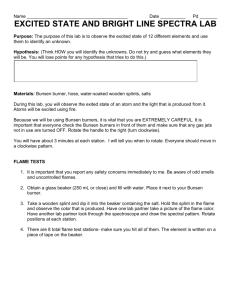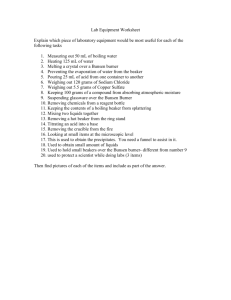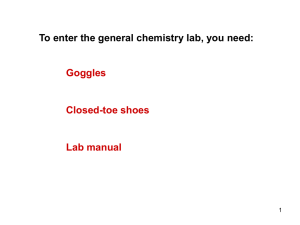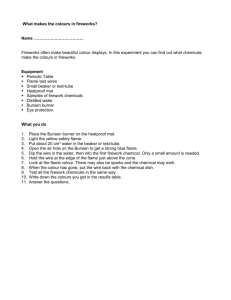20-1 Examples of change of state
advertisement
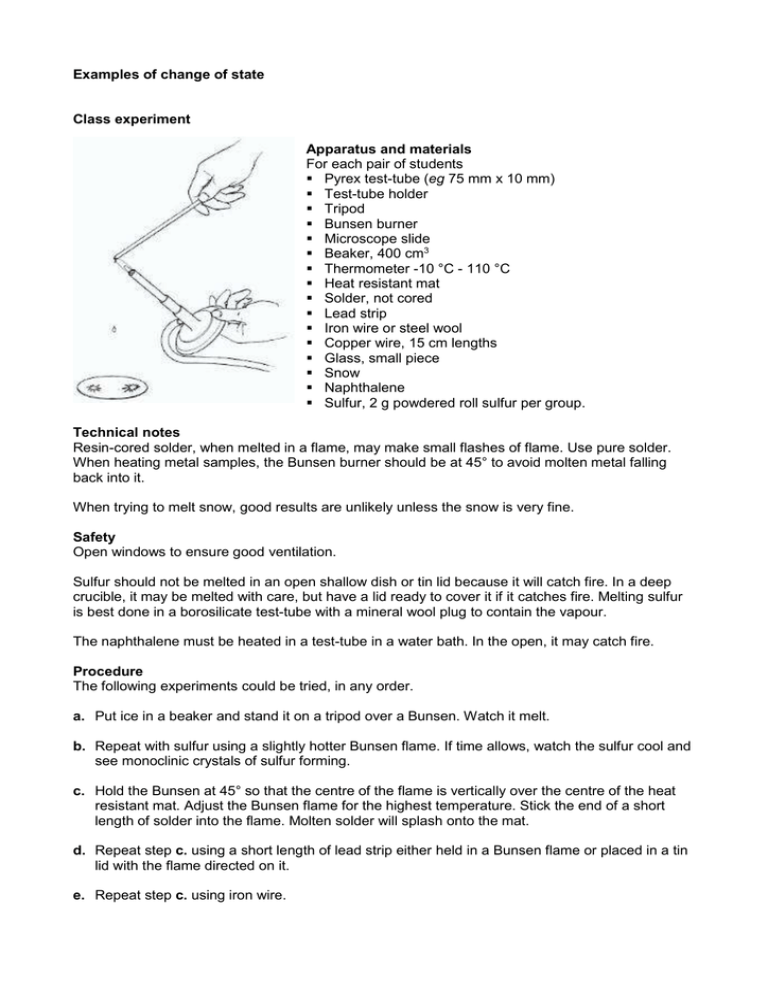
Examples of change of state Class experiment Apparatus and materials For each pair of students Pyrex test-tube (eg 75 mm x 10 mm) Test-tube holder Tripod Bunsen burner Microscope slide Beaker, 400 cm3 Thermometer -10 °C - 110 °C Heat resistant mat Solder, not cored Lead strip Iron wire or steel wool Copper wire, 15 cm lengths Glass, small piece Snow Naphthalene Sulfur, 2 g powdered roll sulfur per group. Technical notes Resin-cored solder, when melted in a flame, may make small flashes of flame. Use pure solder. When heating metal samples, the Bunsen burner should be at 45° to avoid molten metal falling back into it. When trying to melt snow, good results are unlikely unless the snow is very fine. Safety Open windows to ensure good ventilation. Sulfur should not be melted in an open shallow dish or tin lid because it will catch fire. In a deep crucible, it may be melted with care, but have a lid ready to cover it if it catches fire. Melting sulfur is best done in a borosilicate test-tube with a mineral wool plug to contain the vapour. The naphthalene must be heated in a test-tube in a water bath. In the open, it may catch fire. Procedure The following experiments could be tried, in any order. a. Put ice in a beaker and stand it on a tripod over a Bunsen. Watch it melt. b. Repeat with sulfur using a slightly hotter Bunsen flame. If time allows, watch the sulfur cool and see monoclinic crystals of sulfur forming. c. Hold the Bunsen at 45° so that the centre of the flame is vertically over the centre of the heat resistant mat. Adjust the Bunsen flame for the highest temperature. Stick the end of a short length of solder into the flame. Molten solder will splash onto the mat. d. Repeat step c. using a short length of lead strip either held in a Bunsen flame or placed in a tin lid with the flame directed on it. e. Repeat step c. using iron wire. f. Repeat step c. using copper wire. g. Boil a little water in the beaker or test-tube. It takes a few minutes to boil dry. This experiment could obviously be a continuation of a., provided only a little ice was used. h. Put a small quantity of naphthalene into the test-tube to a depth of about 2.5 cm. Heat some water in the beaker over a Bunsen burner and hold the test-tube in it with the test-tube holder. Observe the melting and solidifying of the naphthalene. i. If snow is available, a melting experiment could be carried out. Heat a 400 cm3 beaker, crammed with snow, over a small Bunsen flame that is kept burning at a steady rate. Hold the Bunsen under the container of snow for only a quarter of a minute at a time. After each quarter of a minute ‘dose’ of heating, move the Bunsen away (but keep it burning) and stir carefully until the temperature stops changing. Then give another dose of heating. Continue dose after dose until the temperature is 30 °C or higher. Teaching notes 1. Although this activity may seem trivial, many students will not be aware that some metals melt at a relatively low temperature. 2. These experiments demonstrate that the state of matter depends on temperature. The process of melting and freezing, and evaporation and condensing, should be discussed in terms of the change in structure of the materials as well as change in volume. Link it to the students’ growing understanding of atomic and kinetic theory. 3. Perfume, or other 'smelly' substances, diffusing throughout the laboratory will also illustrate that gases and vapours move. 4. There may be suggestions that gases are made of particles farther apart than those in solids and liquids. At this point it is useful to say, ‘Suppose each of you were a particle (atom or molecule). Suppose the whole class are molecules of a piece of some stuff. If the stuff is solid, how would you look? Stand in the middle of the room and show how you would be arranged in a solid … (crowded close in regular array eg with arms touching shoulders). Now show me how you would be arranged in a liquid … (crowded close but arranged irregularly and able to move around). Now show how you would look if you were particles of a gas … (spread out). 5. It is, of course, possible to measure the temperature of cooling naphthalene and to plot a cooling curve showing solidification. Other materials, such as cetyl-alcohol, produce good cooling curves. This could lead to a useful discussion of what happens to the energy of the particles during change of state. 6. Heating a solid brings it to a point where the springy forces can no longer hold the atoms together. Atoms break loose and move about close to neighbours with random motion. This is the process of melting, in which atoms gain energy. When a solid is formed from a liquid, atoms lose energy and the surroundings are warmed. 7. A simple but effective experiment is to wipe some alcohol on the back of the hand, using cotton wool. Students will feel the temperature fall as it evaporates. Do NOT issue alcohol to a class while they are using Bunsen burners. www.practicalphysics.org/go/print/Experiment_182.html?topic_id=4&collection_id=55.

